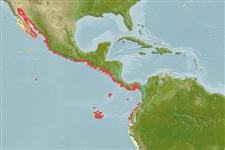Environment: milieu / climate zone / depth range / distribution range
Ecologia
marinhas demersal; intervalo de profundidade 46 - 90 m (Ref. 9342). Subtropical; 33°N - 10°S, 116°W - 78°W (Ref. 5222)
Eastern Pacific: southern California in the USA, south to Peru.
Tamanho / Peso / Idade
Maturity: Lm ? range ? - ? cm
Max length : 100.0 cm TL macho/indeterminado; (Ref. 5222)
Espinhos dorsais (total) : 11; Raios dorsais moles (total) : 16 - 18; Espinhos anais: 3; Raios anais moles: 8. Distinguished by the following characteristics: dark red or brown head and body; darker pectoral fins than body; tips of interspinous dorsal fin membranes darker than the rest of the membranes; prominent black moustache streak occurs above maxilla; depth of body contained 2.4-2.6 times in SL; head length 2.3-2.4 times in SL; convex interorbital area; rounded preopercle, finely serrate, enlarged serrae at angle but covered by skin; distinctly convex upper edge of operculum (Ref. 89707).
Common in the Gulf of California. Occasionally encountered in isolated reefs and sandy bottoms near the coast at depths of 46 to 90 m; uncommon in shallow waters (Ref. 89707).
Life cycle and mating behavior
Maturidade | Reprodução | Desova | Ovos | Fecundidade | Larvas
Craig, M.T. and P.A. Hastings, 2007. A molecular phylogeny of the groupers of the subfamily Epinephelinae (Serranidae) with revised classification of the epinephelini. Ichthyol. Res. 54:1-17. (Ref. 83414)
Categoria na Lista Vermelha da IUCN (Ref. 130435: Version 2024-1)
Ameaça para o homem
Harmless
Utilização humana
Pescarias: pouco comercial
Ferramentas
Relatórios especiais
Descarregue XML
Fontes da internet
Estimates based on models
Preferred temperature (Ref.
123201): 17 - 26, mean 19.9 °C (based on 16 cells).
Phylogenetic diversity index (Ref.
82804): PD
50 = 0.5001 [Uniqueness, from 0.5 = low to 2.0 = high].
Bayesian length-weight: a=0.01072 (0.00607 - 0.01892), b=3.03 (2.88 - 3.18), in cm total length, based on LWR estimates for this species & Genus-body shape (Ref.
93245).
Nível Trófico (Ref.
69278): 3.9 ±0.7 se; based on size and trophs of closest relatives
Resiliência (Ref.
120179): Muito baixo, tempo mínimo de duplicação da população maior que 14 anos (Preliminary K or Fecundity.).
Fishing Vulnerability (Ref.
59153): High vulnerability (60 of 100).
Nutrients (Ref.
124155): Calcium = 39.8 [16.6, 82.2] mg/100g; Iron = 0.73 [0.39, 1.41] mg/100g; Protein = 18.9 [17.0, 20.6] %; Omega3 = 0.353 [0.211, 0.601] g/100g; Selenium = 30.9 [14.9, 65.2] μg/100g; VitaminA = 12.5 [3.6, 49.6] μg/100g; Zinc = 0.516 [0.363, 0.769] mg/100g (wet weight);
